
The harp is a stringed musical instrument that has a number of individual strings running at an angle to its soundboard; the strings are plucked with the fingers.
This article presents lists of the literary events and publications in 1903.

Jan Ladislav Dussek was a Czech composer and pianist. He was an important representative of Czech music abroad in the second half of the 18th century and the beginning of the 19th century. Some of his more forward-looking piano works have traits often associated with Romanticism.
Marcel Georges Lucien Grandjany was a French-American harpist and composer.
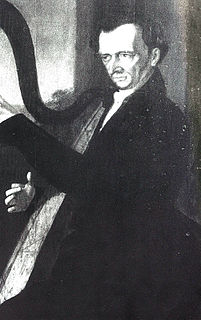
Jean-Baptiste Krumpholz was a Czech composer and harpist.

Elias Parish Alvars, was an English harpist and composer. He was born as Eli Parish in Teignmouth, Devon; his father was a local organist. His baptismal record at St James’s Church, West Teignmouth, reads: "Eli, son of Joseph and Mary Ann Parish".

The cross-strung harp or chromatic double harp is a multi-course harp that has two rows of strings which intersect without touching. While accidentals are played on the pedal harp via the pedals and on the lever harp with levers, the cross-strung harp features two rows so that each of the twelve semitones of the chromatic scale has its own string.

Sébastien Érard was a French instrument maker of German origin who specialised in the production of pianos and harps, developing the capacities of both instruments and pioneering the modern piano.

The pedal harp is a large and technologically modern harp, designed primarily for use in art music. It may be played solo, as part of a chamber ensemble, or in an orchestra. It typically has a range of six and a half octaves, and weighs about 36 kilograms (80 lb). The pedal harp is about 1.85 metres high, has a depth of 1 metre, and is 55 centimetres wide. The notes range from the C♭ three octaves below middle C to three and a half octaves above, usually ending on G♭. Using octave designations, the range is C♭1 to G♭7.
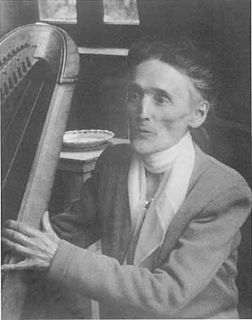
Henriette Renié was a French harpist and composer who is known for her many original compositions and transcriptions, as well as codifying a method for harp that is still used today. She was a musical prodigy who excelled in harp performance from a young age, advancing through her training rapidly and receiving several prestigious awards in her youth. She was an exceptional instructor and contributed to the success of many students. She gained prominence as a woman in an era where fame was socially unacceptable for women. Her devotion to her religion, her family, her students, and her music has continued to influence and inspire musicians for decades.
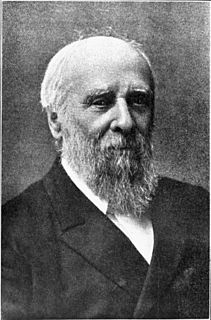
Henry Willis, also known as "Father" Willis, was an English organ player and builder, who is regarded as the foremost organ builder of the Victorian era. His company Henry Willis & Sons remains in business.

Gaveau of Paris was a French piano manufacturer. The company was established by Joseph Gabriel Gaveau in 1847 in Paris and was one of the three largest piano makers in France. Its factory was located at Fontenay-sous-Bois.
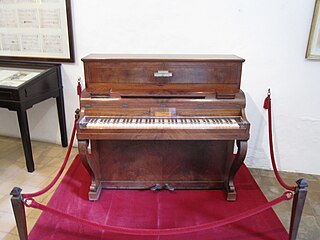
Pleyel et Cie was a French piano manufacturing firm founded by the composer Ignace Pleyel in 1807. In 1815, Pleyel's son Camille joined him as a business partner. The firm provided pianos to Frédéric Chopin, and also ran a concert hall, the Salle Pleyel, where Chopin performed his first – and last – Paris concerts. Pleyel's major contribution to piano development was the first use of a metal frame in a piano. Pleyel pianos were the choice of composers such as Debussy, Saint-Saëns, Ravel, de Falla and Stravinsky and of pianists and teachers Alfred Cortot, Philip Manuel and Gavin Williamson. Nineteenth-century musicians involved in the company's management included Joseph O'Kelly and Georges Pfeiffer.

Dieudonné-Félix Godefroid was a Belgian harpist, who composed for his instrument and for the piano.

Olivia Francisca Buckley née Dussek (1799–1847) was an English harpist, organist and composer. She was born in London, the daughter of Czech composer Jan Ladislav Dussek and Scottish composer Sophia Corri. Dussek left his wife, and Olivia was taught harp and piano by her mother, making her debut at the age of eight at the Argyle Rooms. She married Richard William Buckley and had ten children.

Introduction and Allegro for Harp, Flute, Clarinet and String Quartet was written by Maurice Ravel in 1905. It premiered on 22 February 1907 in Paris.
Jacob Hochbrucker was an eighteenth-century harp maker and musician credited with the invention of the single-action pedal harp popularized in Europe between 1729 and 1750 by his descendants, and particularly by the Dauphine, Marie Antoinette, who performed on it after her arrival in Paris in 1770.
Victor Salvi ; was an American-born harpist, harp maker, and entrepreneur. Salvi, who has been called "harpmaker of the world", was of Italian descent. Born in Chicago, Illinois, he immigrated back to Italy several years into his professional career. Credited for transforming the harp industry, he began his career as a musician, and turned to building harps.
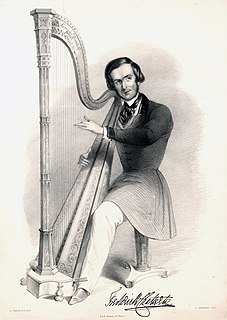
Frederick Chatterton was one of the leading British harpists of the mid to late 19th-century and a composer of music for the harp.
















